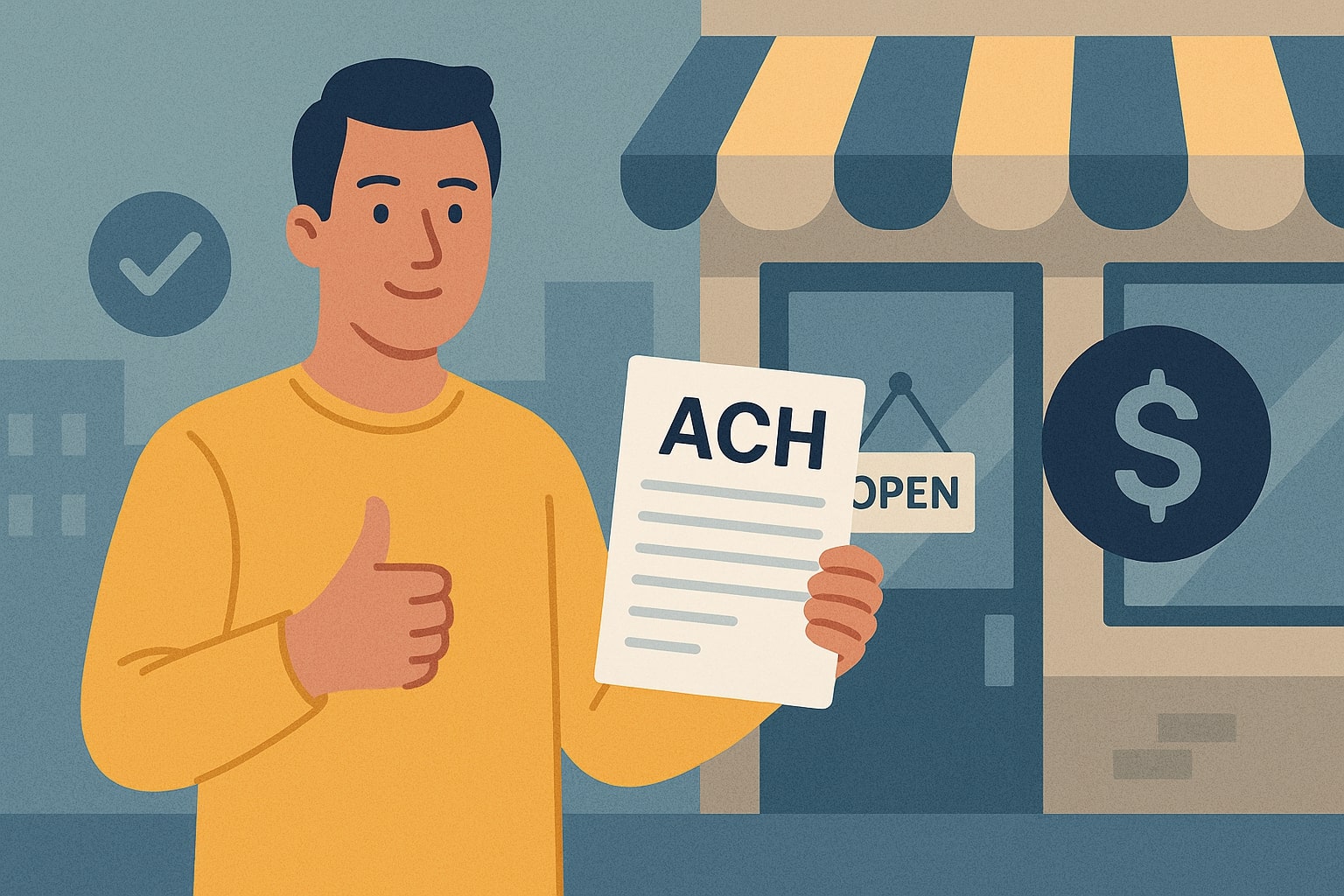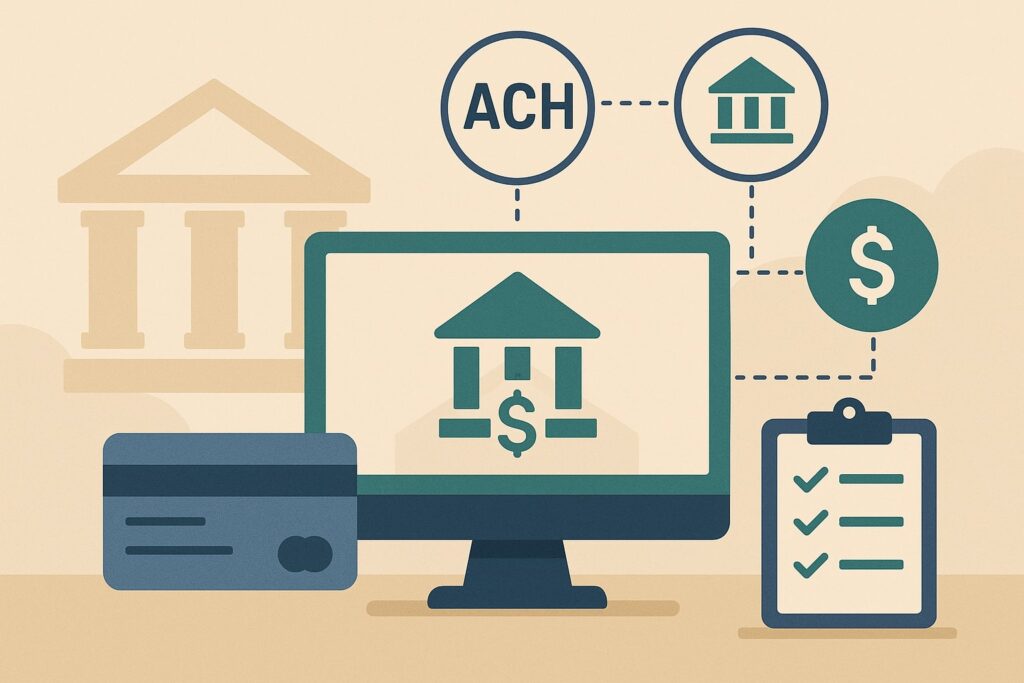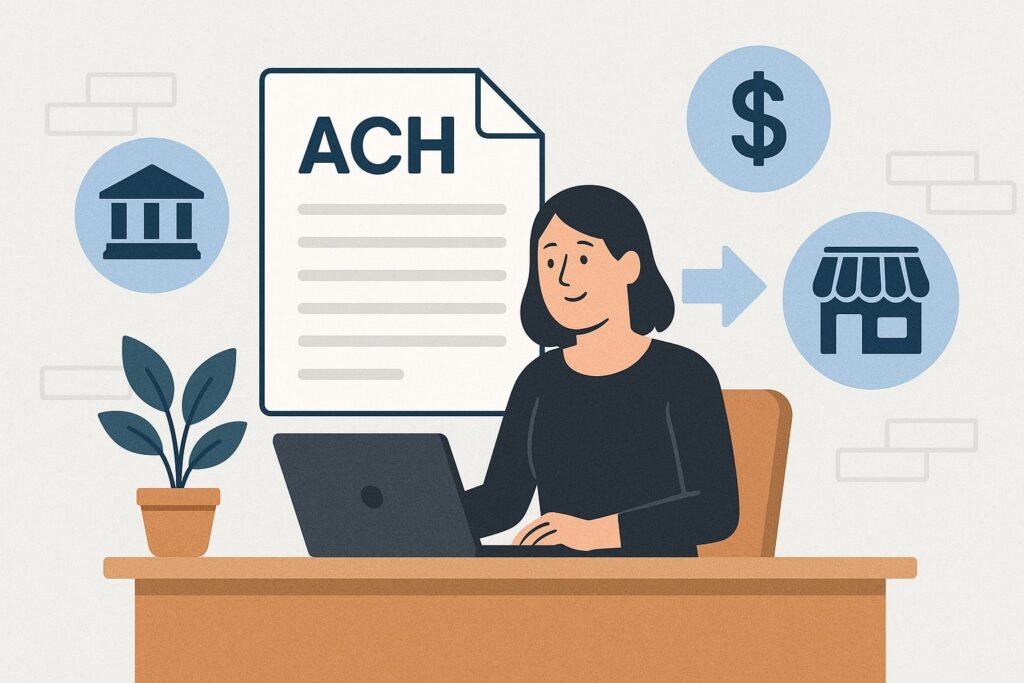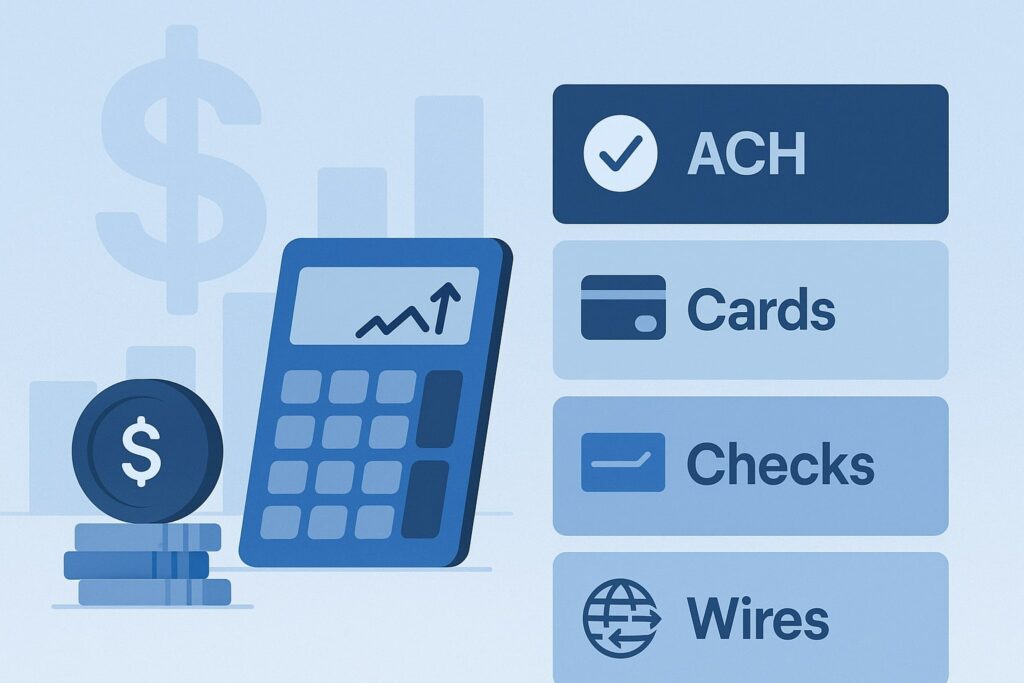
By achforbusiness October 21, 2025
Accepting ACH payments can transform how a small business in the U.S. gets paid, manages cash flow, and builds trust with customers. ACH payments move money electronically from one bank account to another through the Automated Clearing House network, cutting card fees, paper checks, and manual work.
For small businesses that run on thin margins, ACH payments offer lower costs, fewer headaches, and more reliable settlement. When you add recurring billing, invoicing, and accounting integrations, ACH payments become a strategic tool rather than just another way to collect funds.
This guide explains ACH payments in plain English, shows where the savings come from, and walks through practical steps to start, scale, and safeguard ACH payments for your business.
What Are ACH Payments and How They Work

ACH payments are bank-to-bank transfers processed in batches over a secure U.S. network called the Automated Clearing House. Unlike card transactions that rely on card brands, ACH payments move directly between deposit accounts, which reduces intermediaries and costs.
When a customer authorizes you, your processor submits an ACH debit to pull funds or an ACH credit to push funds. The transaction flows through your processor’s Originating Depository Financial Institution and on to the customer’s bank, then settles to your account.
ACH payments cover payroll direct deposit, vendor payments, B2B invoices, rent, tuition, subscriptions, and charitable donations. For small businesses, ACH payments shine when ticket sizes are higher, margins are tight, or repeat billing is common.
Because ACH payments are bank-based, you avoid expired card numbers, card reissues, and certain interchange complexities. ACH payments can also be scheduled, automated, and paired with robust authorization language that protects both parties.
With modern gateways, you can collect bank info via micro-deposits or instant bank verification, then store tokens rather than raw account numbers to stay secure.
Why ACH Payments Matter for Small Businesses in the U.S.

Small businesses compete on price, service, and speed. ACH payments support all three. Lower processing costs mean you can keep prices competitive without sacrificing profit.
Automated invoicing and ACH payments shorten days sales outstanding, which improves cash flow and keeps operations humming. Because ACH payments are familiar to U.S. customers through payroll and bill-pay, they feel safe and convenient.
ACH payments also reduce operational friction. Instead of chasing paper checks or dealing with card declines, you can schedule ACH payments on due dates, set up autopay, and notify customers automatically.
This reduces back-and-forth emails and lets your team focus on service. ACH payments create a professional impression for B2B buyers, nonprofits, professional services, trades, and medical practices.
The experience is simpler: click an invoice link, authorize ACH payments once, and you’re done. Over time, ACH payments increase retention because clients associate your brand with predictable, painless billing.
Cost Savings: ACH vs. Cards, Checks, and Wires

For many small businesses, processing fees determine margins. Cards typically combine percentage rates with per-transaction fees and assessments. Checks have hidden costs: printing, mailing, bank trips, lockbox fees, and the time you spend reconciling.
Wires are fast but expensive and impractical for routine invoices. ACH payments generally cost less than cards and significantly less than wires, making them ideal for invoices of $200, $2,000, or even $20,000.
Savings compound with volume and average ticket. If your average invoice is $750, even a one-percent difference in fees adds up across the year. ACH payments often carry a flat or low fixed fee that you can absorb, pass through, or discount against for early payment.
Because ACH payments are electronic, you eliminate check float delays and reduce the chance of misapplied payments. Modern gateways apply ACH payments directly to invoice numbers, which improves reconciliation and lowers bookkeeping costs. The result is a cleaner P&L and time you can reinvest in growth.
Cash Flow and Settlement Timelines for ACH Payments
Cash flow is the heartbeat of a small business, and ACH payments help you control it. Standard ACH payments typically settle within one to two business days after submission. Same Day ACH options can accelerate funding when time matters.
With smart cut-off scheduling, you can batch ACH payments daily, align settlement with payroll or payables, and smooth out week-to-week swings.
ACH payments are predictable. You can set invoice due dates to ensure debits occur on business days, and configure automatic retries if a debit returns for non-sufficient funds.
Because ACH payments are bank-account based, they’re not as vulnerable to card expiries or reissues. That stability reduces involuntary churn for subscriptions and retainers.
When you can forecast settlement from ACH payments accurately, you negotiate better terms with suppliers, plan inventory purchases, and avoid short-term borrowing. Over a quarter, small improvements in ACH payments timing translate to fewer cash crunches and less interest expense.
Security, Compliance, and Risk Management for ACH Payments
Security and compliance are essential when you move money. ACH payments use bank rails subject to strict operating rules, which require authorization, proper data handling, and timely return processing.
A reputable ACH processor will tokenize bank data, enforce encryption in transit and at rest, and provide secure forms for account entry. Many also support instant bank verification via trusted aggregators. That reduces the risk of mis-keyed routing numbers and increases the success rate of your ACH payments.
Risk management for ACH payments focuses on three areas: identity, authorization, and returns. Verify the account owner before initiating high-value ACH payments. Present clear authorization language explaining the amount, frequency, and revocation process.
Monitor return codes to catch issues early. With the right tools, you can set velocity limits, delay fulfillment until funds post, and flag unusual patterns. ACH payments create an auditable trail that protects your business in disputes, while policies like Positive Pay and bank-level controls add another layer of defense.
Customer Experience and Retention Benefits of ACH Payments
Great customer experience reduces churn and boosts lifetime value. ACH payments offer a smooth path to pay: a short bank-connect step, a one-time authorization, and no wallet hunting. For B2B customers, ACH payments align with their AP routines and approval workflows.
For households, ACH payments feel like utility autopay—set it once and forget it. When ACH payments are integrated into branded invoices and portals, your brand gains credibility.
Retention improves because ACH payments lower friction on renewals and recurring charges. Card-on-file can fail for reasons beyond your control; ACH payments are less likely to decline unexpectedly.
Proactive notifications, flexible due dates, and self-service portals let clients update bank accounts and review histories without contacting support. Over time, customers grow to prefer ACH payments for predictable bills, especially if you offer a small incentive or remove convenience fees for this method.
Use Cases Across Verticals Where ACH Payments Shine
ACH payments aren’t just for enterprise finance. Small businesses across the U.S. benefit every day. Professional services—CPAs, attorneys, consultants—use ACH payments to collect retainers and monthly engagements without card fees eating margins.
Trades—HVAC, electrical, plumbing—secure deposits and final balances via ACH payments linked to estimates and invoices. Medical, dental, and veterinary practices rely on ACH payments for payment plans and memberships.
Education and childcare providers use ACH payments for tuition and after-care with recurring debits that match academic calendars. Nonprofits accept ACH payments for recurring donations, where even a small fee difference turns into meaningful funding over a year.
B2B suppliers and wholesalers favor ACH payments for larger tickets and net-terms invoices. Property managers use ACH payments for rent collection with late-fee logic and ledger sync. If your business invoices, bills on a schedule, or handles bigger tickets, ACH payments will likely become your best-value payment method.
How to Start Accepting ACH Payments: A Step-by-Step Path
Getting started with ACH payments is straightforward. First, choose a payments partner that supports ACH debits and credits alongside cards, invoicing, and recurring billing.
Complete underwriting, which assesses your business model, average ticket, and typical monthly volume. Provide bank details for settlement and, where required, submit sample authorization language for ACH payments.
Next, configure your invoicing or checkout. Add “Pay by Bank” or “ACH payments” as an option, and decide whether to enable instant bank verification or micro-deposit verification.
Prepare compliant authorization templates for one-time pulls, recurring debits, and variable amounts with customer notice. Train your team to explain ACH payments benefits—lower fees, secure bank connection, and predictable billing.
Finally, roll out ACH payments in phases: start with trusted clients, measure adoption, and refine your messaging. As comfort grows, invite more customers to switch, and consider modest incentives that make ACH payments the default.
Technical Integration: Invoicing, Recurring Billing, APIs, and Accounting
To unlock full value from ACH payments, connect the rails to your daily tools. Modern gateways expose APIs for creating customers, saving bank tokens, and initiating ACH payments.
If you’re on platforms like QuickBooks, Xero, or accounting-centric CRMs, enable built-in ACH payments links on invoices. For subscriptions, use a billing engine that supports proration, dunning, and ACH payments retries.
Map webhooks to your back office. When an ACH payment succeeds, update the invoice status and record the transaction ID. If a return occurs, trigger alerts and pause services until resolution.
Reconciliation is smoother when line-item metadata—invoice number, customer ID—rides along with each ACH payment. For developers, prioritize idempotent requests, unique references, and clear error handling around return codes.
Over time, you’ll build a dependable pipeline where ACH payments flow from customer click to ledger entry with minimal manual touch.
ACH Payments for Mobile, In-Person, and P2P-Style Experiences
While ACH payments are traditionally online or invoice-based, mobile and in-person experiences are catching up. Many providers now offer “Pay by Bank” flows optimized for smartphones, where customers authenticate with their bank app and authorize ACH payments in seconds.
For field service teams, invoice links sent by SMS or QR codes let customers approve ACH payments on site. This avoids card minimums, card present hardware costs, and paper checks.
For near-consumer experiences such as clubs, associations, or freelancers, ACH payments provide a professional upgrade over informal apps that aren’t built for business compliance. With ACH payments, you get business-grade authorization, clear descriptors on bank statements, and better bookkeeping.
If you need recurring dues or retainers, ACH payments eliminate card expiration hassles and make renewals automatic. The result is a consistent experience across channels—mobile, desktop, and in person—without juggling multiple tools.
Chargebacks, Returns, and Dispute Handling with ACH Payments
ACH payments don’t have “chargebacks” in the card-network sense, but they do have returns and disputes to manage. Returns occur for reasons like non-sufficient funds, invalid account numbers, or authorization issues.
Each return carries a code that explains the cause. Your goal is to minimize returns with good verification, clear authorizations, and thoughtful timing—such as avoiding large pulls right before weekends or holidays.
When a customer contests an ACH payment as unauthorized, your best defense is a strong authorization trail: time-stamped consent, terms that cover frequency and amount, IP logs, and any signed agreements.
Build a standard operating procedure for returns: notify the customer, assess whether to retry, and apply any applicable fees disclosed in your agreement. Many processors let you set retry logic and send reminders automatically. By treating returns as a manageable exception instead of a crisis, you protect revenue while maintaining trust.
Pricing, Incentives, and Checkout Strategy for ACH Payments
Pricing strategy can nudge customers toward ACH payments. One approach is offering a small discount for ACH payments on large invoices, which shares savings while increasing adoption.
Another is absorbing ACH payments fees while charging a separate convenience fee for cards, subject to local rules and your processor’s policies. Present ACH payments first at checkout and explain the benefits: secure bank transfer, lower costs, and fewer declines.
Messaging matters. Use a concise copy near the payment button: “Save on fees—pay by bank with secure ACH payments.” Include FAQs on your invoices so customers know ACH payments are standard business practice.
For B2B clients with approval workflows, provide PDFs that outline how ACH payments are authorized and revoked. When you pair transparent pricing with clear education, customers gladly switch, and your mix of ACH payments grows month after month.
Common Myths and Realities About ACH Payments
- Myth: ACH payments are slow. Reality: Standard ACH payments are typically next-business-day or two-day, and Same Day options exist for time-sensitive pulls. With smart batching, ACH payments are fast enough for most invoicing and subscriptions.
- Myth: ACH payments are risky. Reality: With proper verification, clear authorizations, and monitoring, ACH payments are highly reliable. Tokenization and secure hosted forms keep sensitive data out of your systems. Returns happen, but processes and policies minimize exposure.
- Myth: Customers won’t share bank details. Reality: Millions of Americans use online bill-pay and payroll direct deposit. With modern bank-connect flows, customers authenticate through their bank and never hand over raw numbers. Explain that ACH payments are standard and secure, and adoption follows.
- Myth: ACH payments don’t work for small tickets. Reality: ACH payments can reduce costs even for modest invoices, especially at scale. For memberships, classes, or maintenance plans, the stability of ACH payments reduces churn and support time, which is as valuable as fee savings.
The Future: ACH Payments, Real-Time Rails, and Interoperability
The U.S. payments landscape is evolving fast, and ACH payments remain foundational. Real-time networks are emerging, but ACH payments continue to dominate recurring billing, payroll, and B2B transfers due to ubiquity and cost-effectiveness.
Expect richer data fields, better fraud controls, and more instant bank-connect options that make ACH payments even smoother.
For small businesses, the future is about choice and orchestration. You’ll offer cards, ACH payments, and potentially instant rails, then route by cost, speed, and customer preference. Invoices will adapt automatically: if a client authorizes ACH payments, the system selects it for the next bill.
With smarter retries and notifications, you’ll see fewer disruptions. As standards improve, reconciliation will include more structured remittance data, making your accounting cleaner with every ACH payment you collect.
Choosing an ACH Payments Provider: What to Look For
The right partner makes ACH payments effortless. Look for a provider that offers ACH payments alongside cards so you can present a unified checkout. Prioritize instant bank verification, secure hosted forms, and tokenization.
Ask about return-rate monitoring, risk thresholds, and configurable retry logic. Ensure your provider supports invoicing, recurring billing, and easy connections to accounting software.
Transparent pricing matters. Request a clear schedule for ACH payments—per-transaction fees, monthly minimums, and any return or reversal costs. Confirm funding timelines for standard and faster ACH payments.
Evaluate the quality of their developer documentation and the availability of webhooks and sandbox environments. Finally, assess support: do you get real humans who understand small-business realities, or only bots? The best partner treats ACH payments as a growth lever, not merely a feature.
Implementation Checklist and Best Practices for ACH Payments
Start with policy. Draft concise authorization language for one-time and recurring ACH payments, including cancellation instructions and notice periods. Configure your invoice templates to promote ACH payments clearly. Decide whether you’ll offer an ACH payments discount or simply highlight lower costs and reliability.
Next, set operational guardrails. Enable instant bank verification when possible, and fall back to micro-deposits for conservative clients. Turn on notifications for returns and disputes. Align debit schedules with your delivery or service milestones to reduce fulfillment risk.
Train your team on how ACH payments appear on statements and how to help customers update accounts. Review performance monthly: adoption rate, return rate, settlement timing, and support tickets. Small tweaks—like sending reminders two days before debits—can meaningfully improve results with ACH payments.
Sample ACH Authorization Language You Can Adapt
A strong authorization underpins every ACH payment. Aim for clarity without legalese. Your authorization should identify the customer, specify the account to be debited, define amount and frequency, and describe how to revoke consent.
It should state that the customer will receive notice for variable amounts above a threshold and outline how disputes are handled. Present the authorization during checkout or invoice payment, and email a copy automatically.
Store a time-stamped record of consent along with IP address or device fingerprint when collected online. For phone orders, consider a recorded verbal authorization with a confirmation email.
For in-person engagements, use e-signature tools to capture agreement. Keep authorizations accessible for the life of the relationship plus any applicable retention period. With clear, accessible records, you resolve questions quickly and maintain confidence in your ACH payments program.
Reducing Returns and Improving Authorization Quality
Returns happen, but they can be reduced with thoughtful design. Use instant bank verification to avoid typographical errors in routing or account numbers. Provide pre-debit notifications for variable amounts so customers have time to prepare funds. If your audience often pays on specific days, offer flexible due dates to match payroll cycles.
For recurring ACH payments, include amounts, cadence, and expected billing dates in your agreement. If amounts vary, declare how you’ll calculate them and how far in advance you’ll notify customers.
Offer a self-service portal where customers can update bank details. Monitor return codes over time; if one client shows repeated non-sufficient funds, adjust schedules or require prepayment. These steps reduce friction for customers and strengthen the reliability of your ACH payments.
Integrating ACH Payments With Your Accounting Workflow
The real win arrives when ACH payments post cleanly in your books. Use invoice numbers and customer IDs as references on every ACH payment.
Connect your payments platform to your accounting system so settlements auto-reconcile. Map fees to a dedicated expense account and keep a daily cadence for importing transactions.
When a return occurs, your system should auto-reopen the related invoice and notify both AR staff and the customer. Monthly, review ACH payments settlement reports and tie them to bank statements.
The more you automate this loop, the fewer hours you spend chasing exceptions. With ACH payments integrated end-to-end, your financials become timelier, and your decisions become sharper.
FAQs About ACH Payments for U.S. Small Businesses
Q.1: What is the difference between ACH credits and ACH debits?
Answer: ACH credits push funds from your account to a recipient—think payroll or vendor payouts. ACH debits pull funds from a customer’s account with authorization—perfect for collecting invoices, subscriptions, and rent.
Many small businesses use both: ACH debits for receivables and ACH credits for payables. Using the same platform simplifies reconciliation and reporting across all ACH payments.
Q2: How fast are ACH payments, and can I speed them up?
Answer: Standard ACH payments typically settle in one to two business days. Funding can vary by processor and bank cut-off times. If you need faster movement, ask about Same Day ACH for eligible transactions.
You can speed things up by submitting earlier in the day, aligning billing cycles to weekdays, and enabling automated retries that respect bank schedules. These small choices make your ACH payments feel faster.
Q.3: Are ACH payments safe for my customers?
Answer: Yes—ACH payments run on secure bank rails with established operating rules. Protect customers by using tokenization, encrypted forms, and clear authorizations. Consider instant bank verification to reduce manual entry errors.
Provide receipts and pre-debit notices for variable amounts. When customers see professional processes, they trust ACH payments and are more likely to enroll in autopay.
Q.4: What fees should I expect for ACH payments?
Answer: Fees vary by provider but are generally lower than card fees and far lower than wires. Some processors charge a flat per-transaction fee for ACH payments; others add small monthly minimums or return fees.
Ask for a transparent schedule and evaluate total cost based on your volume and average ticket. Most small businesses see immediate savings by shifting suitable transactions to ACH payments.
Q.5: Can I pass along costs or offer discounts for ACH payments?
Answer: Many businesses legally offer a small discount for ACH payments on invoices, especially for larger tickets. Always disclose pricing clearly on quotes and invoices.
If you use convenience fees for other payment methods, ensure you follow applicable rules and any state-level considerations. Transparent communication helps customers choose ACH payments willingly.
Q.6: How do I handle disputed ACH payments?
Answer: Keep strong records: signed or electronic authorizations, terms that explain frequency and amount, and proof of service delivery.
If a customer claims an unauthorized debit, promptly investigate, respond through your processor, and, if appropriate, issue a credit while you resolve the issue. Clear policies and consistent communication keep relationships intact and protect your ACH payments program.
Conclusion
ACH payments turn billing from a cost center into a strategic advantage for small businesses in the U.S. Lower processing costs expand margins without raising prices. Predictable settlement stabilizes cash flow.
Strong authorizations, verification tools, and returns management keep risk in check. Because ACH payments are familiar, customers adopt them readily—especially when you highlight benefits and streamline the experience.
Implementing ACH payments doesn’t require a massive rebuild. Start with a trusted provider, add “Pay by Bank” to invoices and checkout, and present clear authorizations. Integrate webhooks and accounting so every ACH payment posts accurately the first time.
Then track adoption, adjust schedules, and keep refining your messaging. Within a few billing cycles, you’ll see fewer declines, simpler reconciliation, and measurable savings. ACH payments are more than a payment method—they’re a modern, resilient foundation for how your small business gets paid.
Leave a Reply